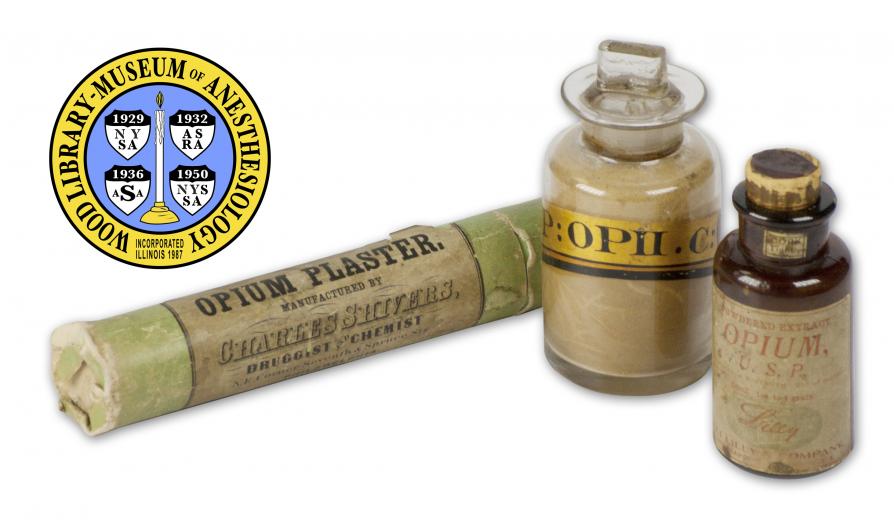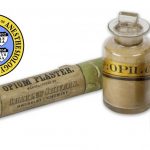Opium
Pictured from left to right is an opium plaster made by Charles Shivers, an apothecary jar for opium, and a bottle for powdered opium extract manufactured by Eli Lilly.
Opium is a substance extracted from a specific kind of poppy plant. Humans have used opium since before recorded history. In 1784, Dr. James Moore (1763-1837), a British surgeon, may have been the first Westerner to record the effectiveness of opium for postoperative pain.
Medicinal plasters were applied to the body for various purposes. Opium plasters were thought to relieve rheumatic or arthritic pain in the areas to which they were applied. The opium once held in the apothecary jar may have been used for a variety of purposes, as opium was a key ingredient in a number of medicinal mixtures. The powder once held in the Eli Lilly jar was 20% morphine and may have been diluted so that it could be injected for pain relief. Morphine was the first of a number of pain relieving substances isolated from opium. Also see the opium tin from the 'U.S. Army Surgeon’s Field Companion' kit.
Catalog Record: Opium
Three Catalog Records (aivg, aivv, aivw):
Access Key: aivg
Accession No.: 1999-04-06-1
Title: Opium plaster / manufactured by Charles Shivers.
Corporate Author: Charles Shivers.
Title variation: Alt Title
Title: Shivers opium plaster.
Title variation: Alt Title
Title: Shivers’ opium plaster.
Publisher: Philadelphia : Charles Shivers, [1841-1895].
Physical Description: 1 tube : paperboard ; 20 x 3.5 dia. cm.
Subject: Opium.
Subject: Drug Packaging.
Subject: Analgesics, Opioid.
Subject: Pain – drug therapy.
Subject: Anesthetics, Topical.
Note Type: General
Notes: Title from manufacturer’s label; Dates basted on biographical information
(Charles Shivers dead, 1897).
Note Type: Citation
Notes: Charles Shivers dead: famed for his plasters. Am Drug Pharm Rec. 1897;30:147.
Note Type: Citation
Notes: Wood GB. A Treatise on Therapeutics, and pharmacology or Materia Medica, vol
1. Philadelphia: J.B. Lippincott, 1856:766.
Note Type: Physical Description
Notes: A paperboard tube for holding cloth treated to make a plaster; The outside of
the tube is light green and quite worn; One end is missing; The label on the
tube reads, “OPIUM PLASTER. [new line] MANUFACTURED BY [new line] CHARLES
SHIVERS, [new line] DRUGGIST AND CHEMIST [new line] N.E. Corner Seventh &
Spruce Sts. [new line] PHILADELPHIA.”; The label is light brown with black
text.
Note Type: Reproduction
Notes: Photographed by Mr. William Lyle, July 28, 2010; Photographed with an Eli
Lilly powdered extract opium bottle (SydPlus aivw) and an opium apothecary
jar (SydPlus key aivv).
Note Type: Historical
Notes: Charles Shivers (1814-1897) was an apothecary well known during his time for
producing high quality adhesive plasters. He invented a machine to aid in the
manufacture of his plasters and was reported to produce up to 50,000 yards a
week in his Philadelphia laboratory (Charles Shivers dead, 1897). Opium
plasters were thought to relieve rheumatic or arthritic pain in the areas to
which they were applied (Wood, 1856).
Access Key: aivv
Accession No.: 2010-09-17-1
Title: P: Opii. C: : [Opium apothecary jar].
Title variation: Alt Title
Title: P: Opii. C:.
Title variation: Alt Title
Title: Opium apothecary jar.
Publisher: [S.l. : s.n., 1800-1930.]
Physical Description: 1 bottle : glass ; 11 x 5.5 dia. cm.
Subject: Opium.
Subject: Drug Packaging.
Subject: Analgesics, Opioid.
Note Type: General
Notes: Title from label on bottle with descriptive note.
Note Type: Citation
Notes: Brownstein MJ. A brief history of opiates, opioid peptides, and opioid
receptors. Proc Natl Acad Sci U S A. 1993;90(12):5391-5393.
Note Type: Citation
Notes: Hamilton GR, Baskett TF. In the arms of Morpheus: the development of morphine
for postoperative pain relief. Can J Anesth. 2000;47(4):367-374.
Note Type: Physical Description
Notes: Clear, cylindrical glass jar with glass stopper; Black and gold label with
markings, “P: OPII. C:”; The glass stopper measures approx. 3 x 3 dia cm and
has a rectangular handle; The inside of the bottle is coated with a light
brown powder.
Note Type: Reproduction
Notes: Photographed by Mr. William Lyle, July 28, 2010; Photographed with a Charles
Shivers opium plaster (SydPlus key aivg) and an Eli Lilly powdered extract
opium bottle (SydPlus key aivw).
Note Type: Historical
Notes: Opii is Latin for Opium. Opium is a substance extracted from a specific kind
of poppy, Papaver somniferum. The oldest evidence of the cultivation of the
opium poppy dates back 5,000 years. Opium was a key ingredient in a number of
medicinal mixtures used by Europeans, including “Laudanum” and “Paregoric”
(Hamilton & Baskett, 2000). In 1784, Dr. James Moore (1763-1834), a British
surgeon, was the first Westerner to record the effectiveness of opium for
postoperative pain (Hamilton & Baskett, 2000). In roughly 1805, Friedrich
Sertürner (1783-1841), a German apothecary, was the first to isolate an
active substance from opium (Brownstein, 1993 ; Hamilton & Baskett, 2000). He
called it morphine, a reference to the Greek god of dreams, Morpheus. The
desire for a non-addictive drug that could relieve pain as well as morphine
led to the discovery of other active elements in opium as well as the
synthesis of opiate-like substances, including codeine, heroin, meperidine
and methadone (Brownstein, 1993).
Access Key: aivw
Accession No.: 1999-04-27-1 J
Title: Powdered extract opium, U.S.P. / Eli Lilly & Company.
Corporate Author: Eli Lilly and Company.
Title variation: Alt Title
Title: Eli Lilly powdered extract of opium bottle.
Publisher: Indianapolis, Ind. : Eli Lilly, [1876-1930].
Physical Description: 1 bottle : glass, cork ; 10 x 4 dia. cm.
Subject: Opium.
Subject: Analgesics, Opioid.
Subject: Drug Packaging.
Note Type: General
Notes: Title from markings on the bottle’s label.
Note Type: Citation
Notes: Brownstein MJ. A brief history of opiates, opioid peptides, and opioid
receptors. Proc Natl Acad Sci U S A. 1993;90(12):5391-5393.
Note Type: Citation
Notes: Hamilton GR, Baskett TF. In the arms of Morpheus: the development of morphine
for postoperative pain relief. Can J Anesth. 2000;47(4):367-374.
Note Type: Physical Description
Notes: Cylindrical, amber glass bottle with a cork stopper; The label is soiled and
the markings faded; From top to bottom, the manufacturer markings include,
“POWDERED EXTRACT [new line] OPIUM, [new line] U. S. P. [new line] STANDARD
OF STRENGTH–20% of morphine [new line] alkaloid. [ new line] DOSE–1/4 to 1
grain [new line, Eli Lilly logo, new line] ELI LILLY & COMPANY, [new line]
INDIANAPOLIS, INDIANA [Indiana only partially visible to to wear of and stain
on label] U.S.A.”; Marking in the base of the bottle: “E.L. & CO. [new line]
12”; A small label on the neck of the bottle is marked with, “CORK Tightly”;
Top of cork has a small remainder of a worn and stained label with only
“Lilly” discernable.
Note Type: Reproduction
Notes: Photographed by Mr. William Lyle, July 28, 2010; Photographed with a Charles
Shivers opium plaster (SydPlus key aivg) and a opium apothecary bottle
(SydPlus aivv).
Note Type: Historical
Notes: Opium is a substance extracted from a specific kind of poppy, Papaver
somniferum. The oldest evidence of the cultivation of the opium poppy dates
back 5,000 years. Opium was a key ingredient in a number of medicinal
mixtures used by Europeans, including “Laudanum” and “Paregoric” (Hamilton &
Baskett, 2000). In 1784, Dr. James Moore (1763-1834), a British surgeon, was
the first Westerner to record the effectiveness of opium for postoperative
pain (Hamilton & Baskett, 2000). In roughly 1805, Friedrich Sertürner
(1783-1841), a German apothecary, was the first to isolate an active
substance from opium (Brownstein, 1993 ; Hamilton & Baskett, 2000). He called
it morphine, a reference to the Greek god of dreams, Morpheus. The desire for
a non-addictive drug that could relieve pain as well as morphine led to the
discovery of other active elements in opium as well as the synthesis of
opiate-like substances, including codeine, heroin, meperidine and methadone
(Brownstein, 1993).


